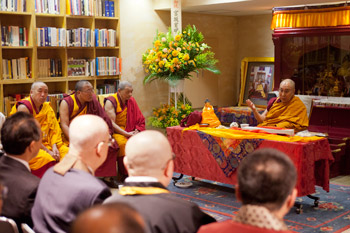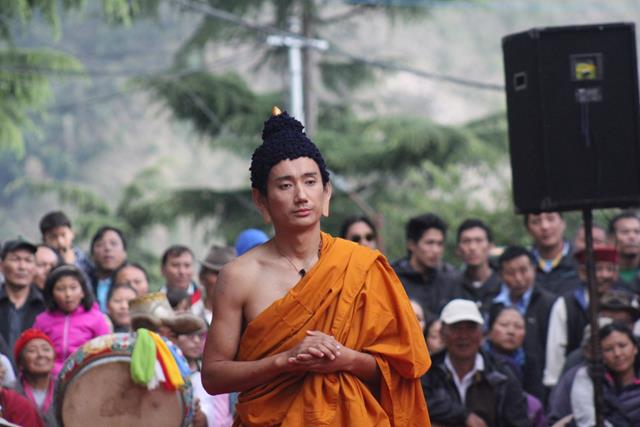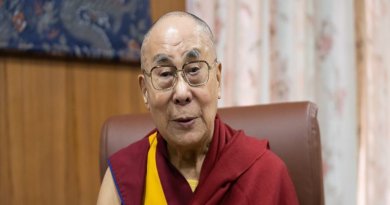A Day of Fruitful Tibetan-Japanese Exchanges
[dalailama.com] Tokyo, Japan, 5 April 2015 – Despite light drizzle and a grey sky, today began on a bright note with His Holiness the Dalai Lama’s visit to the newly relocated Liaison Office of his Representative for East-Asia. He recited prayers of consecration and, as tea and rice were served, selected a volume from the Kangyur to read. Addressing the 40 people who were present for the occasion, he said:
“I’d like to express thanks to all our friends here. I very much appreciate your support. We Tibetans have had links with Japan since the time of the 13th Dalai Lama, who sent a learned Lama here. Around the same time Ekai Kawaguchi came to Tibet and studied at Sera Monastery. I remember seeing a photograph of him in the 13th Dalai Lama’s room. The Second World War broke out not long after the 13th Dalai Lama passed away so links didn’t resume until we came to India as refugees.
“My eldest brother, Taktser Rinpoche, spent time here in our early days in exile and learned to speak Japanese. Later, when Jayaprakash Narayan convened an Afro-Asian Conference on Tibet in India a Japanese delegation took part. Shortly afterwards we sent a small group of Tibetans to study here. Since then, I have been able to come to visit and Japanese monasteries and scholars have taken an active interest in Tibetan Buddhism.”
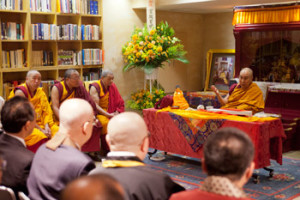
His Holiness went on to extol the great store of knowledge of the workings of the mind and emotions to be found in the books written by the masters of the great Indian University of Nalanda. He explained how the content of these books can be seen as dealing with science, philosophy and religion. A two volume selection of Buddhist science has already been prepared and English, Chinese, Russian and Korean translations are underway. He spoke of the need to find methods to tackle our emotions and build healthier minds and suggested that this science of mind can be studied in a straightforward academic way.
“My wish is not to propagate Buddhism,” he stressed, “but to enable interested people to utilize the knowledge it reveals for the benefit of all humanity.”
He mentioned reputable scientists like Richard Davidson who share his enthusiasm.
Meeting a group of 120 Tibetan students, he told them that the role of Tibetans in India is to represent Tibetans in Tibet to the wider world. He said the determination shown by Tibetans in Tibet is the inspiration for those outside to work for the cause without losing hope. He told them too of the importance of appreciating that Tibetan Buddhism, as a pure extension of the Nalanda tradition, is an authentic transmission of Buddhist knowledge and practice. He mentioned that only the Tibetan tradition employs logic and analysis based on the writings of Dharmakirti and Dignaga.
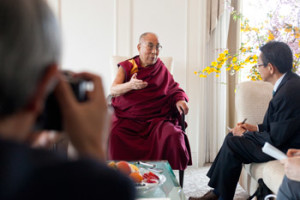
In a brief encounter with about 70 Chinese he noted that Tibetans and Chinese both respectfully recite the ‘Heart Sutra’. However, he encouraged them to be 21st century Buddhists and to discover what the text really means. This will involve study, analysis and the use of reason. Outlining his three commitments he invited his Chinese listeners to adopt them too.
“We should try to promote human values as a source of happiness, encourage inter-religious harmony and explore what Tibetan religion and culture is really about. Then share with other people what we find out.”
During an interview with Sapio magazine, His Holiness was pressed to say how Tibetan Buddhism would survive if no 15th Dalai Lama were recognised. He replied:
“The lineage of Dalai Lamas began in the late 14th century, whereas the establishment of Buddhism in Tibet took place about seven centuries before that. So, similarly, in the future, whether a Dalai Lama is there or not the Buddhist tradition will remain. The Nalanda tradition is not dependent on one individual.”
When the interviewer protested that the Dalai Lama is the symbol of the Tibetan Buddhist tradition, His Holiness told him bluntly that he was making a wrong interpretation.
“We follow the Buddha’s teachings even though he’s no longer with us. We follow Nagarjuna too, and he’s not here either. The Nalanda tradition employs reason and logic. It exemplifies the Buddha’s own advice that his followers should not accept his words blindly because he said them, but should examine and investigate them as a goldsmith tests gold.”
About Xi Jinping he mentioned his having said last year in Paris and Delhi that Buddhism has an important contribution to make to Chinese culture. His Holiness described this as a surprising statement from a Chinese leader whose party, following Marx, believes that religion is the opiate of the masses. His Holiness felt it’s related to what other Chinese intellectuals have told him that ethics in China is at its lowest point for 5000 years. He said that it is narrow-minded totalitarianism that is really like an opiate.
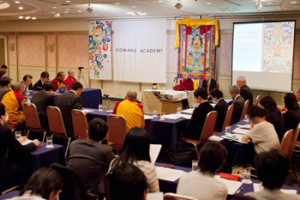
On the other hand Xi Jinping has also been emphasising the rule of law. His Holiness repeated his view that the Chinese judicial system needs raising to international standards and that censorship is immoral. He said that the 1.2 billion Chinese people not only have a right to realistic information, but having found it have the ability to judge right from wrong.
The final question of the interview was:
“Obama called you a friend; what’s your secret?”
“My smile,” His Holiness laughed. “And that I try to be honest and truthful.”
Voicing his appreciation of their work, His Holiness told a team of volunteers who have worked to launch and maintain a Japanese version of his office’s website:
“Last year I suggested that we might start a Japanese website to cater to the growing numbers of people who show an interest when I come to visit. I’d like to thank all of you who have made this possible. This is all part of our effort to make the knowledge of the mind we derive from the Nalanda tradition available to anyone who’s interested. I’d especially like to see it incorporated into our education systems in the hope of steadily creating a happier more peaceful world. Not something I expect to see take place, but something I hope can be achieved by the end of this century.”
In the afternoon, His Holiness joined 150 other participants attending a conference on Buddhist studies organised by the Drepung Gomang Academy of Japan. Yasahiro Nagano, President of the Japan Association of Tibetan Studies made a few welcoming remarks. Yoichi Fukuda then opened proceedings, which were conducted in a mixture of Tibetan, Japanese and English, with an interesting survey of the ‘Past and Future of Tibetan Studies in Japan’. This was followed by Akira Saito’s presentation ‘Madhyamaka Studies in Present-day Japan and Abroad’.
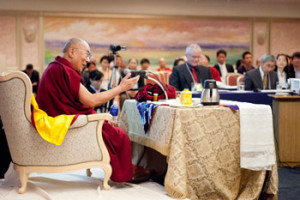
He explained that he had been working on Indian Madhyamaka philosophy for the past 30 years. Recently more original texts have been discovered and recognised. These include Chandrakirti’s ‘Prasannapada’, Buddhapalita’s seminal work, one fifth of which has been found and recently published, and a work of Bhavaviveka’s. A copy of ‘Madhyamakavatara’ has been identified among texts in the Potala collection, while 16 manuscripts of ‘Prasannapada’ are now available, of which the 1st and 17th chapters have now been published.
Shoryu Katsura explained in his ‘Studies of Buddhist Logic in Japan’ that unlike Tibet with its extensive array of texts on logic and reason, only four texts translated into Chinese by Xuanzang reached Japan. He mentioned evidence that at one point Japanese monks also engaged in debate.
Tsuguhito Takeuchi in his presentation ‘Universal Nature of Tibetan Civilization – a view from Old Tibetan Textual Study’, declared himself ignorant of Buddhist scholarship, saying his field was linguistics. He mentioned Tibetan texts found in Dunhuang, Lobnor and Khotan, all on the southern silk route, which included official documents as well as scriptures. He said there is evidence the Tibetan language continued into the 11th century, well after the fragmentation of the Tibetan Empire.
At the end of the first session His Holiness remarked that what he’d heard was wonderful and very interesting. The second session began immediately with Lee Collins one of the founders of Unicode explaining how it has become the basis of digital text. It enables scholars to search and establish context. He quoted lines from an introduction to the Heart Sutra as a source of inspiration. The Buddha says:
“I teach the Dharma in the language of all beings human and non-human.”
Again His Holiness expressed admiration and appreciation, while conceding that such technology was beyond him.
Kazushi Iwao presenting ‘New Trends in Tibetan Studies in Japan’ dated the start of such researches back to 1812. He said a philological approach was now matched by field based study. He identified 10 Japanese who made it to Tibet and experienced life and study there prior to the Chinese intrusion. He remarked that the Japan Association of Tibetan Studies started in 1954 is the oldest such body in the world, and yet Tibetan studies are still not a separate academic field in Japan.
In ‘Logic, Practice and Poetry in Tibetan Buddhism’ Hiroshi Nemoto quoted extensively from Je Tsongkhapa’s ‘In Praise of Dependent Origination’.

In his concluding remarks His Holiness once more expressed appreciation and admiration for the work that had been presented, thanking the scholars on behalf of six million Tibetans.
“We are very concerned about how to preserve our rich culture. Today, Chinese hard-liners consider that the unique qualities of Tibetan culture represent the seeds of separatism. I tell Chinese I meet ‘Look at India. In the north, south, east and west they have people using different languages and different scripts, but because each of these groups of people feel they are accorded equal status and equal treatment, they happily remain within the Indian Union’. If the Chinese were to trust all their peoples equally, these differences among them would not be a cause for concern.
“I’m a student, a student of the Nalanda tradition, and when I listen to these new things you have to tell us, it makes me feel young.”
“Today, we are facing a moral and mental crisis. We need to train people in ethics, in understanding the mind and emotions, not for a few weeks but from the start of their education in kindergarten up to the end at university. We are developing courses to enable this to happen. Consequently, the future will be in the hands of those of you who belong to the 21st century. You have the opportunity and responsibility to build a better humanity. This means developing warm-heartedness, not with a view to liberation or the next life, but in relation to this very life, here and now. So, continue your researches, but also ask yourselves now and then, ‘How can I contribute to human beings being happier and more peaceful?’”

